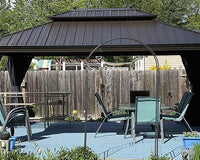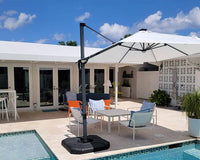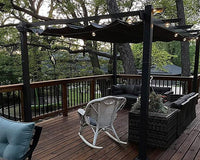A pergola is a beautiful architectural element that can elevate an ordinary backyard or patio to an elegant outdoor living space. It establishes the space, provides filtered shade, and has immense aesthetic value. But its elegantly open design has homeowners concerned with its durability when it is subjected to forceful weather.
Is the structure for bright afternoons up to handling forceful winds or sheet of frozen snow? The solution is to learn the engineering and design elements that classify a pergola as such a seasonal structure for all four seasons.
What Forces of Nature Your Pergola Is Up Against
To be storm-proof, it is useful to start from an understanding of the two fundamental forces that the pergola has to withstand: wind and snow. These forces exert enormous, distinct pressures upon any outdoor covering.
Wind load is the force that the wind exerts upon a structure. It happens in two main ways. The first is lateral force, the actual force of the wind exerting force upon the posts and pergola sides. The second, and often more powerful, force is uplift. It happens when the wind runs by and under the structure of the roofing, creating a difference of pressure to try to lift it from the foundation.
Whereas the snow load is merely a measurement of weight, it is the weight of packed-up ice and snow that is exerting a downward, heavy force upon the pergola's rooftop. It is usually in pounds per square foot (PSF) and is a critical factor in any climates that see enormous winter storms. An otherwise-heavy, icy snow can be rather unexpected in weight, and underestimation of it can foretell structural failure.
Understand Wind Resistance Ratings
When you're shopping for a pergola, one of the most important specifications to look for is its wind resistance rating, often given in miles per hour (MPH). This number represents the maximum sustained wind speed the structure has been engineered and tested to withstand without failing. It is a direct measure of the pergola's ability to handle a storm.
How It's Determined
This rating isn't just a guess; it's the result of careful engineering and calculations. Designers take into account the strength of the materials, the thickness of the posts and beams, the quality of the connecting hardware, and the security of the anchoring system. A higher MPH rating indicates a more robust design with stronger materials and a more secure construction.
What to Look For
A quality, well-built pergola will have a specific wind rating. For most regions, a rating of 60 MPH is considered standard, but for areas prone to strong storms or hurricanes, you should look for a rating of 100 MPH or higher. It is also wise to check your local building codes, as many municipalities have minimum wind resistance requirements for any permanent outdoor structures. Choosing a pergola that meets or exceeds these local codes is essential for both safety and durability.

Decode Snow Load Ratings
For anyone living in a colder climate, the snow load rating is just as important as the wind rating. This specification, measured in pounds per square foot (PSF), tells you exactly how much weight from snow and ice the roof of the pergola can safely support before the beams risk bending, cracking, or collapsing.
Why It Matters
It's easy to underestimate the weight of snow. While light, fluffy snow might only weigh a few pounds per cubic foot, heavy, wet snow can weigh 20 pounds per cubic foot or more. A few feet of this dense snow on top of a 10x12 foot pergola could easily add up to thousands of pounds of stress on the structure. An inadequate snow load rating puts your investment at serious risk of catastrophic failure during a major winter storm.
Finding the Right Rating for Your Area
The required snow load rating varies dramatically by location. A pergola in Florida may not need a significant rating, while one in Colorado or the Northeast will. You can consult local building codes or climate maps to determine the typical ground snow load for your specific region. Look for a pergola with a PSF rating that comfortably exceeds this number to ensure a safe margin of error.
Key Design and Material Factors That Impact Strength
A pergola's ability to withstand storms is determined by the sum of its parts. From the foundation to the choice of materials, every element plays a role in its overall strength and resilience.
- Material Choice: The material is the foundation of your pergola's strength.
- Wood: Offers a classic look and can be very strong, but it requires regular maintenance like staining or sealing. If neglected, wood can rot and weaken, compromising its structural integrity.
- Vinyl: A low-maintenance option that won't rot. However, lower-quality vinyl can become brittle in extreme cold. High-quality vinyl pergolas are often reinforced with an internal aluminum or steel frame for added strength.
- Aluminum: An excellent choice for durability. It's lightweight, incredibly strong, and naturally resistant to rust and corrosion, making it ideal for high-wind and coastal areas.
- Anchoring and Foundation: A pergola is only as strong as its connection to the ground. For maximum wind resistance, the support posts must be securely anchored. Attaching the posts to concrete footings that are dug below the frost line is the most secure method. Simply bolting the posts to an existing deck or patio slab offers less resistance to uplift forces.
- Hardware and Fasteners: The bolts, screws, and brackets that hold the pergola together are critical. Look for pergolas that use heavy-duty, corrosion-resistant hardware, such as stainless steel. This ensures the connections will not weaken over time due to rust.

Pergola vs. Gazebo: A Note on Storm Resistance
While discussing open-air structures, it's worth comparing the pergola to a similar structure: the Gazebo. The primary difference is the roof. A pergola has an open, slatted roof design, while a Gazebo has a solid, fully enclosed roof. This single difference significantly impacts how they handle wind and snow.
A pergola's open design is actually an advantage in high winds. It allows air to pass through the structure, which dramatically reduces the uplift force trying to lift the roof. A Gazebo, with its solid roof, acts more like a sail, catching the wind and placing much greater stress on its anchors.
However, the roles can be reversed when it comes to snow. A flat-topped pergola can accumulate snow evenly across its entire surface. A well-designed Gazebo, particularly one with a steeply pitched roof, is built to shed snow more effectively, preventing heavy buildup.
Practical Tips for Preparing Your Pergola for a Storm
Regular prep work and maintenance can go a long way to preserve your pergola through a storm.
Annual Inspection
Every year, be sure to give your pergola a thorough inspection. Tighten loose screws or bolts, especially at post anchors and the beam point of connections. Inspect the wood for decay and infestation damage by insects, and for cracks in vinyl.
When a Storm is Approaching
A few simple steps can make a big difference.
- Remove all cloth canopies, sunshades, or screen partitions. These will be blown by the wind and will exert enormous force on the structure.
- Take down hanging plants, string lights, wind chimes, or other outdoor decor.
- Move outdoor furniture, grill, and planters into the house or to a safe area. These become deadly flying objects during windy conditions.
During Heavy Snowfall
If you find yourself faced with an overly heavy snowfall that may be over the weight capacity of your pergola, you can use a long-handled roof rake to carefully scoop off the top snow. Be sure to only try to do so if it is feasible for you to attempt from the ground.

Pergola Durability: Making Informed Storm-Proof Choices
A quality pergola is so much more than a delicate garden feature; it's a sturdy and durable extension of your own home. Whether it'll hold up to a storm is down to good engineering, sturdy materials, and proper installation. If you're informed about wind and snow load ratings and pick a structure that is suitable for your local climate, then you can spend with your head held high. A top quality pergola that is serviced properly will withstand the storm and be ready for your return when the sun is out again.




